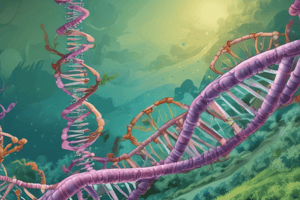Podcast
Questions and Answers
What is the primary focus of genetic engineering?
What is the primary focus of genetic engineering?
- Creating chemical reactions
- Manipulating genetic material (correct)
- Maintaining sterile environments
- Synthesizing proteins
Which process can generate a billion copies of the desired DNA segment?
Which process can generate a billion copies of the desired DNA segment?
- Gel permeation
- Ion exchange chromatography
- Polymerase Chain Reaction (PCR) (correct)
- Electrophoresis
Electrophoresis separates molecules based on which characteristic?
Electrophoresis separates molecules based on which characteristic?
- Presence of charges (correct)
- Molecular weight
- Solubility
- Absorbance of light
Which technique involves the use of a suitable vector to transfer a gene to a new cell?
Which technique involves the use of a suitable vector to transfer a gene to a new cell?
What is a common alternative name for genetic engineering?
What is a common alternative name for genetic engineering?
What characteristic allows DNA to migrate to the anode during electrophoresis?
What characteristic allows DNA to migrate to the anode during electrophoresis?
Which instrument is NOT typically used in isolating and characterizing macromolecules?
Which instrument is NOT typically used in isolating and characterizing macromolecules?
In what year was the polymerase chain reaction (PCR) discovered?
In what year was the polymerase chain reaction (PCR) discovered?
What is introduced in genetic engineering to manipulate genes?
What is introduced in genetic engineering to manipulate genes?
Which combination technique is used in separating DNA fragments?
Which combination technique is used in separating DNA fragments?
Flashcards are hidden until you start studying
Study Notes
Genetic Engineering
- Deals with alteration of genetic material (DNA and RNA)
- Involves manipulation of genetic material towards a desired end in a directed and predetermined way, using "in vitro" process
- Can involve repairing defective genes, replacing defective genes, artificially synthesizing new genes, transferring genes, introducing new genes, and manipulating genes for improvement of living organisms
Recombinant DNA Technology
- Also known as gene cloning
- Defined as the formation of new combinations of heritable material by the insertion of nucleic acid molecules produced outside the cells into a host organism
Gene Cloning/rDNA Technology
- Basic requirements include instruments and devices such as gel permeation, ion exchange chromatography, spectroscopy, mass spectrometry, and electrophoresis
- Techniques used include electrophoresis, agarose gel electrophoresis, PAGE, SDS PAGE, and polymerase chain reaction (PCR)
Electrophoresis
- Separation of charged molecules by applying an electric field
- Used for separation of DNA, RNA, and proteins
- DNA, being negatively charged, migrates to anode, and smaller fragments move faster and separate faster
Polymerase Chain Reaction (PCR)
- Amplification of gene of interest through PCR
- Discovery by Kary Mullis in 1985
- Generates a billion copies of desired segment of DNA or RNA in a few hours with high accuracy and specificity
- Completely automated process with automatic thermal cycles for denaturation and renaturation of double-stranded DNA
Technique of Gene Cloning and rDNA Technology
- Involves transferring a gene of known function from its normal location into a new cell via a suitable vector
- Transferred gene is replicated normally and passed on to the next progeny
Studying That Suits You
Use AI to generate personalized quizzes and flashcards to suit your learning preferences.




